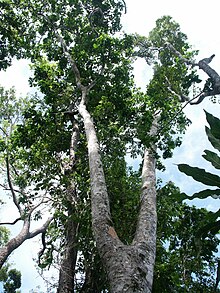Intsia bijuga
| Intsia bijuga | |
|---|---|
 |
|
| Scientific classification | |
| Kingdom: | Plantae |
| (unranked): | Angiosperms |
| (unranked): | Eudicots |
| (unranked): | Rosids |
| Order: | Fabales |
| Family: | Fabaceae |
| Genus: | Intsia |
| Species: | I. bijuga |
| Binomial name | |
|
Intsia bijuga (Colebr.) Kuntze |
|
| Synonyms | |
|
|
Intsia bijuga (commonly known as Borneo teak, Johnstone River teak, Moluccan ironwood, Pacific teak and scrub mahogany) is a species of flowering tree in the pea family, Fabaceae, native to the Indo-Pacific. It ranges from Tanzania and Madagascar east through India and Queensland, Australia to the Pacific islands of Fiji and Samoa. It grows to around 50 metres (160 feet) tall with a highly buttressed trunk. It inhabits mangrove forests.
The tree has a variety of common names including ipil, merbau and kwila. In the Philippines, it also known in some areas as taal.
The bark and leaves of the ipil are used in traditional medicines. The tree's timber, called merbau or kwila, is a very durable and termite-resistant wood, making it a highly valued material for flooring and other uses. The wood can also be used to extract a dye. Merbau can contain a "gold" fleck that runs through the grain, considered to be attractive by some. Due to extensive logging of the tree, it is endangered in many places in Southeast Asia, and almost extinct in some. Extensive amounts were purchased for the venue of the 2008 Summer Olympics in China, which is the largest importer of the wood. The wood is used for flooring in U.S. and European markets where it is commonly sold under different names. Both licensed and unlicensed mills harvest the wood.
According to Greenpeace large amounts of ipil timber sourced from illegal logging is being imported into China where there are lax import rules. Greenpeace are targeting users in Western countries in order to halt the trade in ipil wood. Greenpeace claims that at the current rate of logging the tree will be wiped out within 35 years.
...
Wikipedia

